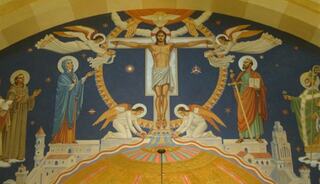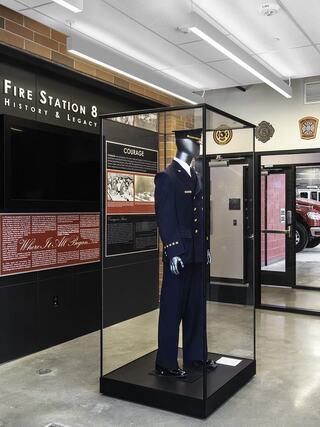
Catholic Liturgy 101: Introduction to Liturgical Catechesis
Published: 12.15.15
Category: Education
Tags: Faith-Based

Occasionally friends and colleagues request a very basic survey of concepts on Catholic worship and liturgical catechesis – that is, teaching on liturgy. We find the progression in the following outline helpful when explaining what liturgy is and why it's important in the big picture of the Catholic faith, as well as how each of the details of what we see and do in worship relates to that belief. For a wonderful video clip series outlining these concepts in a slightly different format: Elements of the Catholic Mass. The majority of the content below can be found in the Catechism of the Catholic Church (CCC), "Part Two: The Celebration of the Christian Mystery," in the General Instruction of the Roman Missal (GIRM), and in Sacrosanctum Concilium (Constitution on the Sacred Liturgy) (SC). All of these writings are well worth the read.
WHAT IS WORSHIP
"Worship is the rendering to God what is owed God by intelligent beings" (Virgil Michel, OSB). Human beings are made for love and communion with God. "God, infinitely perfect and blessed in himself, in a plan of sheer goodness freely created man to make him share in his own blessed life. For this reason, at every time and in every place, God draws close to man. He calls man to seek him, to know him, to love him with all his strength" (CCC 1). Because we know that the greatest act of love is a sacrifice – to lay down one's life (John 15:13) – in worship we offer a sacrifice of praise and give everything we have to God. Worship can be both public (liturgy) and private (devotional, both individual and communal). Both are integral to a healthy and vibrant spiritual life.
WHAT IS LITURGY
Liturgy is public worship – the work of Christ and that of the Church, the Body of Christ. By virtue of our participation in Christ's work as members of the Body, we also participate in the divine life of the Trinity, an eternal exchange of love between the Father, Son, and Holy Spirit. This action – liturgical participation – is our right and duty by baptism (SC 14). As with any sacrament, the action or "doing" is all God's, but as a good parent, he invites us to join in it, both as the worship for which we are made and for the sanctification of the world. Liturgy is an "action" of the whole Christ" (CCC 1136).
PARTICIPATION IN THE DIVINE LIFE OF THE TRINITY
The Trinity is a constant dialogue of love between three distinct persons: Father, Son, and Spirit. Citing the Compendium to the CCC which draws on the writings of Augustine, Archbishop William Lori writes that "the living, eternal bond of love between the Father and Son is the Person of the Holy Spirit." Through the liturgy, we enter the Trinitarian dialogue by sharing in the Paschal mystery of Christ's suffering, death, resurrection, and ascension to the right hand of the Father. This is possible because of our being grafted onto Christ by means of his mystical Body. In turn, Christ presents his Body (of which we are a part) to the Father in sacrifice on our behalf. It is through sharing in Christ's sacrifice to the Father that we participate in the divine life of the Trinity. God's intention for us is that we become divinized – namely, that we participate in the divine life of God and in so doing are made holy like him: "By the mystery of this water and wine, may we come to share in the divinity of Christ who humbled himself to share in our humanity" (Roman Missal).
THE MYSTERY OF FAITH
What exactly is the mystery? During the Mass, we profess what we call the Mystery of Faith. In three different forms, we describe the saving action of God through our participation in Christ's sacrifice on the cross, made present in the Eucharistic meal. This is our memorial, our observance of his command, and also our making present of the events that followed his last supper. The Holy Spirit makes Christ's one true sacrifice of Calvary present at every liturgy. Christ is the head – represented in the priest– we are body, and we always present our worship to the Father. TO the Father, IN the Son, THROUGH the Holy Spirit. This is the proper orientation of our liturgical prayer and action.
HOW TO PARTICIPATE
PRAY the Mass. Be mindful that every action is part of worship. Sing along when appropriate, listen attentively to the readings and homily (if not read and prepare before Mass), pray along earnestly with the prayers, maintain an engaged and reverent posture. Particularly during the Sorsum Corda ("lift up your hearts") and the Doxology ("through him, with him, in him"), these are crucial moments the faithful are being invited to join our individual and collective sacrifices to that of Christ to present perfectly to the Father. While the Eucharist is indeed a heavenly banquet that is a foretaste of the eternal banquet, it is first and foremost Christ's sacrifice and in turn, that of his Body the Church. Our ritual observance of this sacrifice as a Church demands our attention and participation as individual baptized members of the Body.
GRACE
While we are all members of the Body of Christ in the liturgy, the extent to which we are conformed to his image – the extent to which the liturgy transforms us – depends on our choice to engage and cooperate with God's grace or tune out. The same power of the Holy Spirit that is responsible for the mystery of each Sacrament – in the Eucharist it is the presence of Christ in the Eucharist and this sacrifice being offered eternally to the Father on our behalf – is the power we are given when we participate in and receive the sacraments that gives us grace in our lives. The post-communion prayer explains the expected fruit of the mystery that is celebrated (GIRM 89). When we pray the Mass, we cooperate with God's grace, which in turn has an effect on us.
CONVERSION
The effects of grace from the liturgy bring about conversion. Benedict XVI in Sacramentum Caritas explains that authentic liturgical participation presumes conversion from sin. This is why the Church asks of her faithful that they be absolved of mortal sin prior to approaching the altar. The conversion to know the Christ we seek in the breaking of the bread is the transformation that is required for the liturgy to be effective in our lives. Without appreciating the mystery of our sharing in Christ's sacrifice through the liturgy, it is very difficult to expect fruit to come from our participation. We are called to constant conversion. If we are not getting anything out of Mass, this might be why – preparation is crucial. First be reconciled... (SC 55) The goal is for the liturgy to give life to the Christian mission.
MISSION
"In the New Testament the word 'liturgy' refers not only to the celebration of divine worship but also to the proclamation of the Gospel and to active charity" (CCC 1069). In fact, the liturgy demands justice. The natural action at the close of the liturgy is directed outward towards the service to which we are called by our baptism (ite missa est) - GO FORTH! The liturgy is missionary in purpose; in addition to glorifying God, it also sanctifies men and calls them to their creator. Therefore liturgy is inseparable from social justice – our baptismal responsibility to love one another and serve those in need as Christ commanded. The Eucharist is food for our journey. The closing words "Go in peace, glorifying the Lord by your life" tell us that we are to take Christ's love to the world; to be his hands and feet, serving those in need. We can most effectively serve others like Christ if we take on his appearance.
SYMBOLISM
Music, art, and architecture are entryways into the divine. They bring the faith to life and communicate in a way that is deeper and more tangible than concept alone. If we want to more fully participate in the liturgy, we need to be formed in the symbolic and mystical language of the Church. Not only in the prayers and actions of the liturgy, but in the liturgical arts, we see the beauty of the Mass revealed, which leads us into the mystery, into worship. The goal is to PRAY the Mass, but to do so we must be taught the language of mystagogy: the "signs and symbols of invisible (heavenly) realities" (SC 122). These things point to what is happening in the liturgy so that we may understand and participate.
As a result, the liturgy deserves the best that we can realistically provide (or do) with what we have been given. The offering of our gifts and talents to surround the liturgy with beauty and adorn it with layers of meaning is an ancient and praiseworthy practice. However, the Church is clear that how this takes place is a matter that deserves great attention and effort, and will vary between cultures and times. However, this idea is not in conflict with nor diminishes the Christian responsibility to serve.
News & Insights
All Articles

How City Planning, Zoning and Regulations Shape Successful Architecture Projects


